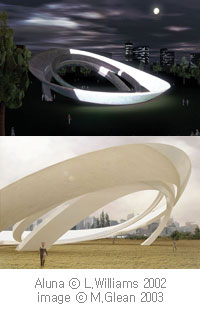 Lunar clock to be built for 2012
Lunar clock to be built for 2012 By Pallab Ghosh | Science correspondent, BBC News
Scientists and artists plan to build a 40m-wide lunar clock by the River Thames by 2012. The aim is to create a new London landmark close to the proposed Olympic stadium as a monument to a more natural way of marking time.
The proposed site is at East India Dock, six miles along the river from Westminster Palace.
Its designers hope their clock will become as iconic as Big Ben, which has been marking time for 150 years.
The site is currently a bedraggled nature reserve.
Across the river are the magnificent skyscrapers of Canary Wharf, and nearby are offices built from sea freight containers.
Inside one of those offices, I spoke to Laura Williams - an East London artist.
She explained that the clock would be powered by the tides from the Thames.
"There are three giant concentric rings made from recycled glass," she told me. "Light shines through from the glass in time with the Moon's cycles so the largest ring shows the lunar phase.
"Gradually the light waxes on all the way around the ring and connects full circle when it's full Moon.
"The second ring is like the big hand of the clock. It's a marker of light that tracks the Moon around the globe so that's the lunar day cycle.
"The third ring - the smallest - is the small hand that tracks the tide as it goes from high tide to low."
The clock has been called Aluna. It is a word from the Kogi indigenous people of Colombia.
"It means memory, possibility," says Ms Williams. "It's also being in tune with the planet's rhythms and living in harmony with our planet."
David Rooney, curator of time at London's Science Museum, is also involved with the project.
He said that people had become "completely besotted with clocks and watches".
"Isn't it about time that we looked up and out a little bit to those natural time cycles of this spinning rock underneath that Moon we all see?
"It's these time cycles that we human beings are wired to - the patterns of day and night."
Moon timeMany of the world's cultures have their own lunar-based calendars.
Dr Usama Hasan is a Muslim astronomer. He believes that in this age of iPods and atomic clocks, there is a greater need than ever for an older way of measuring time.
"For practical purposes, calculating the exact time is the way forward of course," he said, "but I think you lose a a lot of spirit to the way the world works.
"That's why I don't wear a watch and I still judge time, especially the daily prayer times from light and darkness.
"Aluna is a project which tries to connect us back to the cosmic cycle, with nature. I think that's very important especially in the very technological age we live in."
The project is more than a gleam in the eye of these artists and scientists.
According to Laura Williams, a number of large corporations have offered their help.
Lunar clock to be built by River Thames by 2012
London, September 3 : Scientists and artists are planning to build a 40m-wide lunar clock by the River Thames by the year 2012. According to a report by BBC News, the aim is to create a new London landmark close to the proposed Olympic stadium as a monument to a more natural way of marking time.
The proposed site is at East India Dock, six miles along the river from Westminster Palace. It is currently a bedraggled nature reserve.
The designers of the clock hope that the instrument will become as iconic as Big Ben, which has been marking time for 150 years.
Laura Williams, an East London artist, explained that the clock would be powered by the tides from the Thames.
“There are three giant concentric rings made from recycled glass. Light shines through from the glass in time with the Moon’s cycles so the largest ring shows the lunar phase,” she said.
“Gradually, the light waxes on all the way around the ring and connects full circle when it’s full Moon,” she added.
“The second ring is like the big hand of the clock. It’s a marker of light that tracks the Moon around the globe so that’s the lunar day cycle,” said Williams.
“The third ring - the smallest - is the small hand that tracks the tide as it goes from high tide to low,” she said.
The clock has been called Aluna. It is a word from the Kogi indigenous people of Colombia.
“It means memory, possibility. It’s also being in tune with the planet’s rhythms and living in harmony with our planet,” said Williams.
According to Dr Usama Hasan, an astronomer, in this age of iPods and atomic clocks, there is a greater need than ever for an older way of measuring time.
“Aluna is a project which tries to connect us back to the cosmic cycle, with nature. I think that’s very important especially in the very technological age we live in,” said Hasan. --ANI
